The Ray Wallace Debate – Part III
Posted by: Loren Coleman on February 16th, 2006
Okay, today, less words and more photographs, per your requests.
Some facts: Ray Wallace produced fake imprints of Bigfoot tracks that generally followed a routine pattern. These items were revealed by various relatives after Wallace died in 2002. The following are two sets of the ones most often photographed.
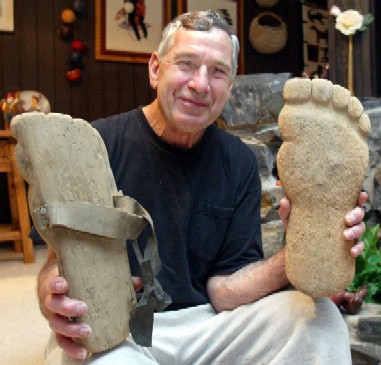
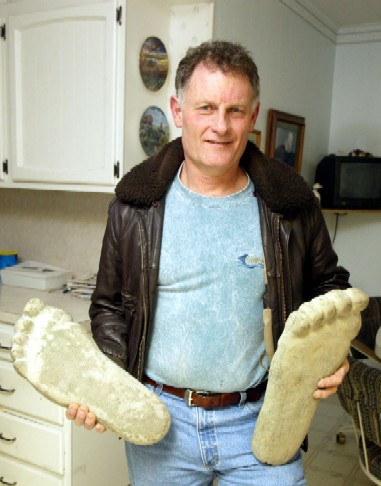
Both photographs © 2002 Dave Rubert. Used with permission.
Facts: The Ray Wallace fakes do NOT match the Jerry Crew October 1958 foot cast that began the use of the word “Bigfoot” in a more widespread fashion, nor do they match the Bluff Creek filmsite prints from 1967, one of which is compared below with a Wallace wooden foot.
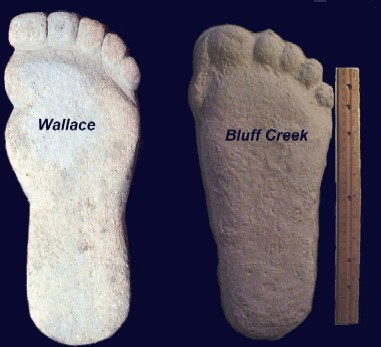
But within various Bigfoot books, you will easily find photos of “Bigfoot” prints that match Wallace’s handiwork. Some are not as easy to identify as others because the placing of footprints is not an exact science and materials do shift around. Nevertheless, some images in some books need to be questioned.
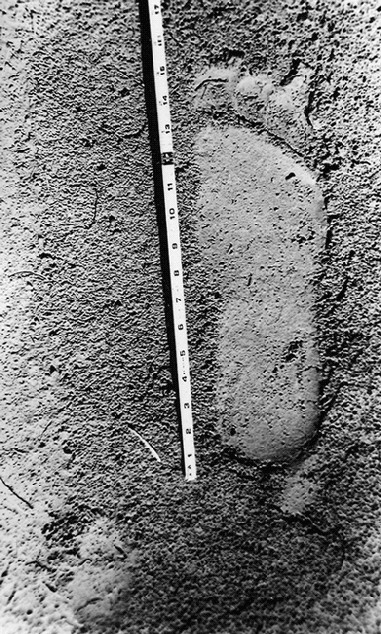
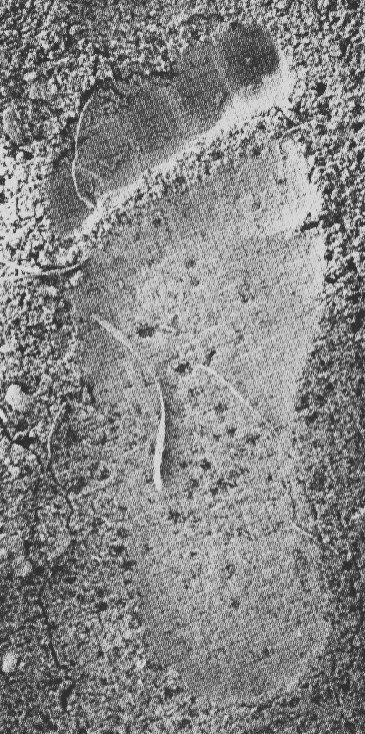
The following comparative series, found frequently on Bigfoot lists and forums, and probably an uncredited creation of Richard Noll’s, shows one of the Wallace fakes next to several well-known Bigfoot prints. Clearly this shows that real cryptids, Sasquatch/Bigfoot, if you will, are out there, leaving authentic footprints. But in the choice of one of Wallace’s tools as the item to compare, versus looking across the board at the testimony/pattern/evidence, or ignoring what is going on with the 1958-1959 Bluff Creek area (so-called Titmus) tracks, we begin to see something sinister occurring here. “Peas-in-a-pod” toes (which I credit to John Napier’s book), a certain angle to the toes, a square hallux, and that troublesome “split-ball” (which Ivan Sanderson loved) are characteristic clues to reveal the Wallace fakes within the background (bad) data that they have become. Remember, this is not to say there are not Bigfoot. Quite the opposite. Remove the Wallace fake material and you actually have a stronger case for Sasquatch. More to come.
Click image for full-size version
Today is just a day to look, examine, and record your thoughts.
To be continued.
About Loren Coleman
Loren Coleman is one of the world’s leading cryptozoologists, some say “the” leading living cryptozoologist. Certainly, he is acknowledged as the current living American researcher and writer who has most popularized cryptozoology in the late 20th and early 21st centuries.
Starting his fieldwork and investigations in 1960, after traveling and trekking extensively in pursuit of cryptozoological mysteries, Coleman began writing to share his experiences in 1969. An honorary member of Ivan T. Sanderson’s Society for the Investigation of the Unexplained in the 1970s, Coleman has been bestowed with similar honorary memberships of the North Idaho College Cryptozoology Club in 1983, and in subsequent years, that of the British Columbia Scientific Cryptozoology Club, CryptoSafari International, and other international organizations. He was also a Life Member and Benefactor of the International Society of Cryptozoology (now-defunct).
Loren Coleman’s daily blog, as a member of the Cryptomundo Team, served as an ongoing avenue of communication for the ever-growing body of cryptozoo news from 2005 through 2013. He returned as an infrequent contributor beginning Halloween week of 2015.
Coleman is the founder in 2003, and current director of the International Cryptozoology Museum in Portland, Maine.

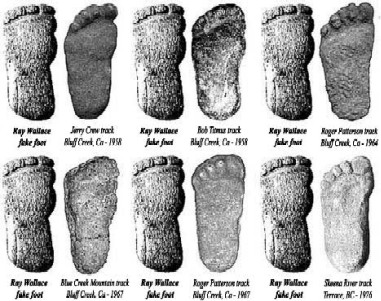









Various aspects of the wooden “prosthetic” seen in the photo at the top of the page cause me to question the Wallace family claims. Note that there is a single strap across the instep designed to hold the foot to the prosthetic. In my own tests, it took at least 3 points of attachment (toes, instep, and heel) to effectively prevent the “prosthetic” from twisting out from under my own own foot while bounding along. If fake trackways were made with the aid of a tow rope attached to a moving car, we can assume the forces involved would be even greater.
What is the second ankle strap made of? My guess is that it is rubber because it is tied with what appears to be a square knot. If the ankle strap was inelastic I think there would be more slack allowed to tie the knot. If it is indeed elastic, perhaps inner tube rubber, is it original? It looks rather “fresh” for rubber that is alleged to be at least 35 years old. If it is elastic, I question whether it would be strong enough to withstand the large rearward forces that tend to pull the foot backwards away from the prosthetic when bounding along.
Is it possible that this particular “prosthetic” was used statically, to produce single tracks for casting, and not dynamically to produce trackways? Of course this would not account for the great deal of wear we see on the plantar surface.
On the other hand, my own tests indicate that a man bounding along wearing fake feet rather naturally produces trackways that lack significant straddle, a feature that Chris Murphy suggested was analogous to the way “First Nations peoples” walked. We see this feature in the Blue Creek Mountain/Onion Mountain trackway photographs.
Wallace reportedly had a variety of wooden feet that were used, according to those that helped. More on that later.
The Blue Creek Mountain/Onion Mountain tracks are some of the most suspect.
Grover Krantz discusses length being varied in the same trackway; David Daegling notes depth as no problem to produce in hoaxes; and John Green even mentions stride as not a significant factor to create.
Most distances between the alleged Wallace fake prints in the well-studied trackways (as well as straddle) are not outside what have been produced in past tests.
This afternoon a local Seattle TV show entitled “Northwest Afternoon” had a segment on Bigfoot. Included was a short video segment on the Ray Wallace wooden feet. Indeed the “prosthetics” shown appeared to be exactly the same ones that appear in this Cryptomundo piece. I guessed correctly that the ankle strap was elastic, as it was shown coming off the wearers foot. The wearer in the short segment was not identified, but it looked to be one of the Wallace family members.
While the man was not really “bounding” along, it was clear he was able to effortless walk along with the wooden feet attached by what I formerly believe was a “flimsy” connection.
This video segment offered proof, beyond a shadow of a doubt, that one can effectively make tracks with these particular Wallace “prosthetics”. My initial doubts in this matter have proven to be incorrect.